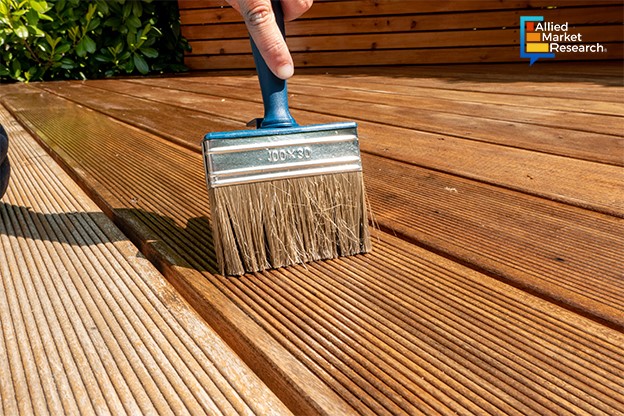How Are Wood Preservatives Helping Furniture Businesses to Extend Longevity of Products?

1 Jul
2024
Highlights
- Introduction
- Technological advancements in wood preservatives
- Growing popularity of eco-friendly preservatives
- Recent developments
Wood is a versatile and widely used material in construction, furniture making, and outdoor structures. However, wood is susceptible to deterioration due to factors such as moisture, insects, and fungi. A variety of wood preservatives are utilized to protect wood from decay and extend its lifespan. These preservatives enhance the efficiency of wood for various applications such as construction, furniture, fencing, and railway sleepers.
In residential construction, treated wood is the preferred material due to its enhanced durability and cost-effectiveness. Treated wood undergoes processing with wood preservatives to protect it from decay, termites, and fungi, thus extending its lifespan and reducing maintenance costs. The use of treated wood in residential construction drives a higher demand for wood preservatives. As the construction industry expands in emerging economies, the need for wood preservatives also rises to treat the large quantities of wood used in building homes and other structures. The wood preservative industry is projected to showcase a notable CAGR of 5.5% by 2033.
Extending the lifespan of wood with advanced technologies
Technological advancements are propelling innovations in wood preservative treatments, improving their effectiveness and flexibility in application. Cutting-edge formulations integrating nanotechnology and microemulsion techniques are being developed to enhance penetration into wood fibers, ensuring thorough protection against biological threats. Furthermore, the application of pressure treatment methods and controlled-release technologies is optimizing the process and improving the effectiveness of wood preservative chemicals across various environmental conditions.
Nanomaterials have shown great potential as wood preservatives, offering several advantages over conventional treatments. Nanomaterials penetrate deeply into the wood and effectively alter its surface chemistry, enhancing properties such as dimensional stability and resistance to biodegradation. The small size of nanoparticles allows them to infiltrate the molecular-scale porosity of the wood cell wall. Nanotechnology enables the controlled release and encapsulation of wood preservatives, increasing their effectiveness through deeper penetration and reduced leaching. Encapsulation in nanocarriers protects the biocides and allows for a more uniform distribution in the wood.
Additionally, incorporating nanoparticles such as zinc oxide (ZnO) and iron oxide (Fe2O3) into wood coatings and treatments helps protect the wood from UV-induced photodegradation. This process reduces color changes and helps maintain the natural appearance of the wood over time.
Growing shift toward eco-friendly alternatives for a sustainable future
There is a growing shift toward the use of eco-friendly wood preservatives. With increasingly stringent environmental regulations, manufacturers are concentrating on creating formulations that have low VOCs and are free from heavy metals such as chromium and arsenic. Water-based preservatives and formulations based on natural compounds are becoming more popular because they have lower environmental impact and offer improved safety profiles for workers and end-users.
In addition to advancements in wood coatings, a significant trend in wood preservatives is the emphasis on sustainable packaging and application methods. Organizations are using eco-friendly packaging materials, reducing waste, and promoting sustainable disposal practices to reduce their carbon footprint. Innovations in application techniques, like spray technologies that reduce overspray, are also enhancing resource efficiency. This comprehensive approach to sustainability showcases the industry's dedication to minimizing its environmental footprint across all stages of the product's life cycle.
Koppers acquired Brown Wood Preserving in April 2024
Koppers Holdings Inc., a company that integrates global offerings of treated wood products, wood treatment chemicals, and carbon compounds, announced that its subsidiary, Koppers Utility and Industrial Products Inc., successfully finalized the acquisition of the majority of assets from Brown Wood Preserving Company, Inc.
Matrìca and LANXESS formed a partnership to develop sustainable biocide preservatives
LANXESS, a specialty chemicals company, partnered with Matrìca in February 2022 to collaborate on producing sustainable biocide preservatives derived from renewable raw materials. This partnership aims to drive the production of eco-friendly preservatives and meet the increasing demand in various industries. The new Preventol preservatives are specifically formulated for consumer products, including household cleaners, laundry care, dishwashing products, paints, and coatings.
To sum up, the evolving landscape of wood preservatives displays a commitment to sustainability and innovation. Advances in nanotechnology and eco-friendly formulations are enhancing the durability and environmental profile of treated wood products. Moreover, a growing focus on efficiency and eco-conscious practices is expected to revolutionize the future of wood preservation in the upcoming era.
For more details on the global wood preservative industry with innovative strategies, contact our experts today!

Koyel Ghosh
Author’s Bio- Koyel Ghosh is a blogger with a strong passion and enjoys writing in miscellaneous domains, as she believes it lets her explore a wide variety of niches. She has an innate interest in creativity and enjoys experimenting with different writing styles. A writer who never stops imagining, she has been serving the corporate industry for the last five years.
Avenue: Entire Library membership of Allied Market Research Reports at your disposal
- Avenue is an innovative subscription-based online report database.
- Avail an online access to the entire library of syndicated reports on more than 2,000 niche industries and company profiles on more than 12,000 firms across 11 domains.
- A cost-effective model tailored for entrepreneurs, investors, and students & researchers at universities.
- Request customizations, suggest new reports, and avail analyst support as per your requirements.
- Get an access to the library of reports at any time from any device and anywhere.
Related Post
-
How are Submarine Cables Transforming Global Connectivity with Enhanced User Experience?
-
Endoscopy Procedures: Transformations in Techniques and Applications
-
AI-Powered Video Analytics: How the Product Actually Works for enterprises
-
Painting Robots: Transforming Precision Coating and Creative Applications
-
Innovations in Pharmacovigilance Systems Advancing Patient Safety
-
Understanding Edge Security: Keeping Data Safe Near the Source
-
Exploring the Use and Advancements of 3D Laser Scanners in Professional Applications
-
Reinforcing Industrial Controls with Smarter Tools and Training








